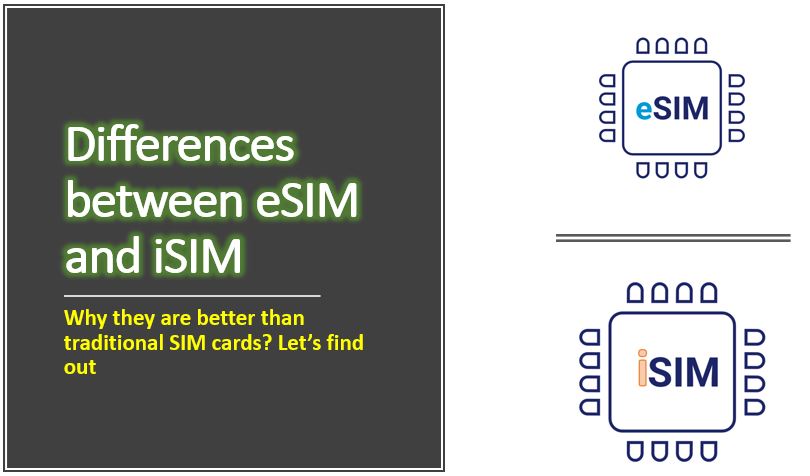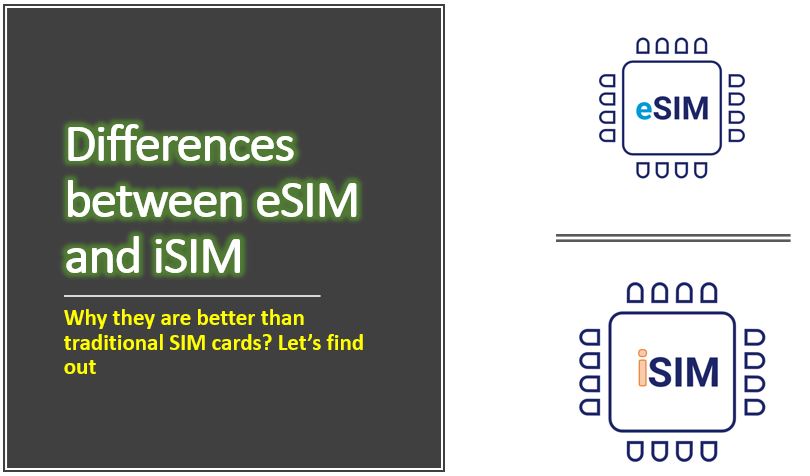SIM cards are no more, fancy new gadgets in today’s world of technology, and we are using it since the time we started using mobile phones. Today, we are living in the age, where we might quickly find eSIM cards and iSIM modules to be mainstream, ditching nano-SIM cards, which is the smallest SIM card form factor, used on the most modern handsets, and even that seems to be ancient. The SIM card plays a very important role in helping us or our mobile phones communicate with the nearest cellular tower, and get a signal from our cellular service provider. Once we connect a SIM card to our mobile, we can make calls, send and receive SMS messages, access the internet and enjoy all the services that are provided by the cellular service provider we have chosen.
But today, the war is to reduce the size of the smartphones and in such a case using an external SIM card, and the SIM-tray can be a bottleneck, and that’s why we started using micro-SIM cards and then gradually moved to nano-SIM cards and today, an external SIM card seems to be unnecessary piece of gadget, when we can easily use eSIM cards, where the SIM card will sit on the motherboard of our mobile phones, making things more convenient. Besides eSIM cards, you can also find iSIM modules, which are not physical SIM cards as well, but they are different from the eSIM cards, which are offered by numerous service providers at least in India in 2019.
So today, we will find the difference between eSIM and iSIM modules. But before that, it is important for us to know how exactly SIM cards work and how exactly a SIM card helps us connect our phones to the cellular network. That will make it easier to comprehend, why having a physical SIM card isn’t as fancy as having the latest Lamborgini

How do SIM cards work?
We all know how SIM cards look, and thus, not going into details about their appearance. SIM is the acronym of the Subscriber Identification Module, and, we will find pay more importance to how exactly SIM cards work. SIM cards are small cards, which contain a very small amount of memory that can be powered by our mobile phones, once we connect the SIM card to it. Within the SIM card that we use, no matter, whether it is a micro-SIM or nano-SIM, there is the two most important information that is stored within the card, the 8-byte IMSI, or the International Mobile Subscriber Identity number and its corresponding authentication code.
When you connect the SIM card to your mobile, the SIM card sends this IMSI number to the nearest cellular network tower, which maintains an index of all the IMSIs and the corresponding authentication codes. When this IMSI number is received, a random number is chosen by the system which is encrypted using the authentication code and a new number is generated which is kept with the system. Now the original number is sent back to the mobile, and authentication code is again used by the SIM, to generate the encrypted number. If the two encrypted numbers match, you eventually get a network to communicate with and enjoy all the services offered by your cellular network.
You can also find the ICCID on the SIM cards, which can be helpful to authorize your SIM card when you are travelling internationally.
Besides all those unique and critical pieces of information, SIM cards can also store contacts and messages, but today in the world, where we use the cloud storage services, we don’t find that important. But it used to be important, when feature phones, or even before that, keypad phones used to be popular. A SIM card could store roughly 100 contacts and 20 SMS messages, which seems to be smaller than a teardrop, compared to the amount of storage we can use on the cloud for storing all contacts and SMS messages.
In spite of all that, the amount of storage that you can find on a SIM card will be less than even 1 MB, in most cases.
In the old mobile phones, we used to use Mini-SIM cards and after that, as we switched to smartphones, we started using micro-SIM cards and nano-SIM cards, as most dual-SIM devices or even single-SIM ones, cannot compromise enough space to accommodate one or two physical cards. The space constraints eventually paved the way for hybrid SIM card slots, which means we can either use one nano-SIM card along with a microSD card or two nano-SIM cards at the same time.
But, when our devices are getting smaller and smaller, and the SIM card is used to store such small pieces of information used for making our handset communicate with the network, what if we could store that information on the mainboard or within the internals of our handsets. Yes, that can be done and the concept of eSIM cards and iSIM modules come into play just there.
Let me talk about eSIM cards and iSIM modules individually, so that it can be easier for you to understand the differences between the two.
What are the eSIM cards?
As I just said, this SIM card stores a little amount of information which helps us to connect the device to the cellular network. Using eSIM cards, you can keep that information within a small embedded SIM card or eSIM, as the acronym goes, that will be embedded with your handset, and that will contain a small memory, good enough for the little information a SIM card has to store. It can be enough to store the IMSI number, authentication, code as I have discussed earlier and each time you switch to a new network, you can rewrite the information on that SIM, as per the instructions that are given by the cellular network using, or by using an app, and if all that seems to be a not so easy task, you can simply scan a QR code to connect the new card and get a network.
Using eSIM cards, the functionality of a SIM card can be extended to smaller gadgets like smart bands, smartwatches, and other very tiny electronic gadgets, where connecting a physical SIM card can be real trouble. As with the help of a SIM card, you can communicate or have a cellular network signal, you can use SIM cards on a number of electronic devices, and those devices can also access the cellular networks besides the Wi-Fi or other communication protocols.
If you have multiple SIM cards for different requirements, and you connect to them from time to time, you will no longer have to physically swap the SIM cards, as you can simply save the settings, and apply them from time to time depending upon which network you want to use. So there is no fear of losing the SIM card as long as the information is stored safely with you physically or on the handset.
As the SIM tray also consumes a lot of space on a smartphone, and the space for a SIM tray cannot be made available on very tiny gadgets, you can easily ditch the SIM tray, as well, by switching two eSIM cards.

What are the iSIM modules?
Even though eSIM hardly consumes any space on your phone, the small size of an eSIM can also be around 5 x 6 mm, and for very tiny electronic gadgets, that amount of space on a motherboard can also be tough to compromise. That’s when the iSIM module can be used, where the SIM card can be embedded right into the processor or the SoC, and just like most other components within that, iSIM can be significantly tiny, and it will hardly consume any space at all. But even if you are super-inquisitive to know how much space it will consume, it will be less than even 1 mm, and I don’t think I need to explain more about how tiny iSIM modules will be.
Thus, you will never have to worry about connecting external SIM cards and the space that it will consume with the latest iSIM modules. As they will be embedded right into the SoC, or the processor, the manufacturing cost is also expected to be quite less than that of physical SIM cards and needless to say, physical SIM cards use nothing but plastic, which is today cancer on this planet.
Thus, iSIM modules are significantly smaller, even than the eSIM cards, it can even be used on any electronic gadgets you can think of, due to the lower manufacturing cost, smaller size, which will eventually make all electronic devices to easily connect to the cellular network. As we all know 5G is just around the corner, and all the devices will need to talk with each other, the use of iSIM modules can really make it feasible for all the devices to have access to the mobile internet and communicate properly.
So, those are the differences between eSIM and iSIM modules, that you should know. Both eSIMs and iSIMs are undoubtedly better than traditional SIM cards, which are prone to tear and break, and we can even lose them if we don’t keep them carefully if we use multiple SIM cards for different requirements.
When can we find iSIM modules within our gadgets?
The technology of eSIM cards is not new, and Samsung Gear S3, Apple Watch Series 3, including some iPads also used eSIM cards. Despite all that, the adoption of eSIM cards is very slow, and talking about India; you can find hardly one or two service providers is offering the support for e SIM cards. It isn’t their fault as well. The choice of handsets with support for eSIM cards is also quite limited, and that’s the biggest reason, why the adaption of eSIM cards remained slow.
But iSIMs has a lot of potentials, and as iSIMs can be embedded right into the SoC, and with 5G just around the corner; we can find most companies adapting to this new technology. Chip design maker ARM, is working on this new technology and we can find iSIM modules in the flagship SoCs in the coming years, and then the same will eventually be available given in entry-level and mid-range SoCs after that.
As Internet-of-Things, Machine-to-Machine communication and Artificial Intelligence will define technology in the coming years, and the internet will also be required, even for the tiniest of electronic gadgets; it is the need of the hour to find something that can allow those devices to connect to the internet. That’s when iSIMs can be useful, so that those devices can easily connect to the internet, besides using Wi-Fi.
It is just a matter of time, where we can find iSIMs within our gadgets and the service providers will have no other option other than allowing the users to use them. So, those are the differences between eSIMs and iSIMs. Do you have any more questions? Feel free to comment on the same below.
Other Articles to Read:
- What are Smart Card Technology and its types?
- Know about Nano Memory Card (NM).
- What should look for in Memory Cards before buying?

Related Posts
Differences between eSIM and iSIM. Why they are better than traditional SIM cards? Let’s find out
Set two SIM cards for iPhone using Krimston Two
How to assign a new name to your SIM card on Android Phone
Incumbent telecom operators following a new strategy to increase revenue. Things you should know
Apple’s leap into dual SIM market. What is E Sim technology? explained